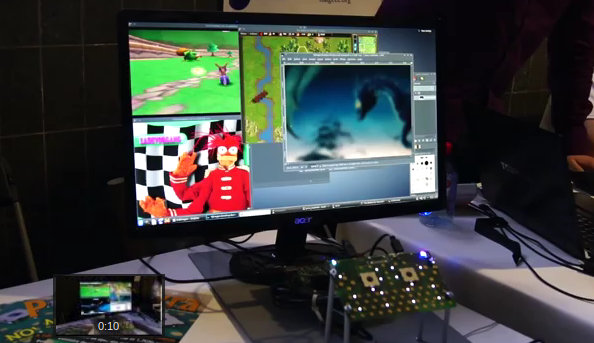Pandora is an open source handheld console which development started as far back as 2007. The project has had ups and downs, and some people have yet to receive the device they pre-ordered. As many components are now more difficult to source, Pandora has reach end-of-life, as Pandora 2 is now being developed with a subset of the original team, but has been renamed to DragonBox Pyra to start afresh. The new version aims to take to the good aspects of the original Pandora, and improve on the bad ones, so that DragonBox will have a faster hardware with a better looking case and better control.

Here are the specifications listed on the project website:
- SoC – Texas Instruments OMAP 5432 SoC with 2x ARM Cortex-A15 @ 1.7Ghz with NEON SIMD, 2x ARM Cortex-M4, Imagination Technologies PowerVR SGX544-MP2 GPU for 3D graphic, and Vivante GC320 GPU for 2D graphics
- System Memory – 2GB RAM (TBC)
- Storage – 2x SDHC card slot
- Display – 1080p 5″ LCD with 20ms response time. (Note: Same display as Google Nexus 5 in FOSDEM presentation, but it will use a resistive touch screen)
- Video Output – HDMI
- Audio I/O – High-Quality speakers, analog volume wheel, headset-Port, built-in-Mic, HDMI Video
- Gaming controls – DPad, 4 shoulder buttons, 6 face buttons, 2 accurate analog controls with push-button
- Keyboard – Backlit QWERTY keyboard
- Connectivity – Integrated dual band Wi-Fi 802.11 b/g/n and Bluetooth 4.0 or 3.0. Optional 3G/UMTS and GPS module
- USB – Full-size USB Host, Micro USB and Mini USB-Ports
- Misc – Fully configurable RGB-LEDs for notifications
- Battery – 4200mAh, same as for Pandora. Battery life is expected to be the same or better as Pandora (10 hours), except for CPU intensive tasks
- Dimensions – About 140 x 84 x 29 mm
The device is expected to run Debian, and capable to run open source games using PSP, Dreamcast, Nintento N64, etc.. emulators. Of course, you’ll also be able to use it as a highly portable Linux device too. The schematics and case design will be publicly available once development is complete. The demo at FOSDEM 2014 did not use GPU acceleration, but both 2D and 3D acceleration should be supported with the drivers released by Texas Instruments. However, after getting feedback at FOSDEM, there are not so sure they’ll use OMAP5432 anymore, and it may be a Qualcomm Snapdragon, AllWinner A80, or even Intel Bay Trail SoC instead. A poll has been launched to determine what the community wants.
The community has funds for development and prototype manufacturing, but they’ll need more funds for the final mass production which will take place in Europe, more exactly in Greece for the casing, and in Germany for the full unit, after the problems they’ve had with Chinese manufacturers for the Pandora project. They are not willing to commit to a deadline, and suggest to subscribe to their blog to follow the project’s progress. Price is likely to be similar to an high-end smartphone.
If you’re interested in knowing more about the history of Pandora’s project, the strength and weakness of the current Pandora console, learn about the diverse manufacturing and community issues they’ve had, you may want to watch Michael Mrozek (EvilDragon), the project leader, presentation at FOSDEM 2014.
Via Liliputing and Obscure Handhelds

Jean-Luc started CNX Software in 2010 as a part-time endeavor, before quitting his job as a software engineering manager, and starting to write daily news, and reviews full time later in 2011.
Support CNX Software! Donate via cryptocurrencies, become a Patron on Patreon, or purchase goods on Amazon or Aliexpress





The following post is interesting as it shows how difficult it can be to buy SoCs if you are a small company: http://pandoralive.info/?p=2808
I’ve had the same issue when I worked for a small HK company “specialized in low volume manufacturing”, most companies did not want to work with us…
PowerVR = NO linux.
Years of promises but nothing useful or even proof of concept ever surfaced as a linux driver for PowerVR. And if you ask today they’ll likely still tell “coming soon”.
@mpiu
I understand Texas Instruments has the GPU drivers for Linux. I’ve read the kernel driver source is available, so you could even use the user space binary blob with different kernel versions.
I read all the comments on this topic in their web site,I think they are going to choose TI,because they
A good feedback and for all the what I read it’s the first choice, arm A15 dual,power vr,run Debian and android, they can’t get nothing more, just work on the drivers and kernel and do their own optimization that is the idea.
For the other side they no even mention A80 allwinner, and I think this a good other choice,maybe
They can get the board to started working but the problem is about quantity.
If they have end-of-lifed Pandora without shipping all the pre-orders, why on earth would anyone trust them to complete a second model? Not trying to troll, I am genuinely curious. Did they refund the pre-orders that didn’t ship, or did the customers lose their money?